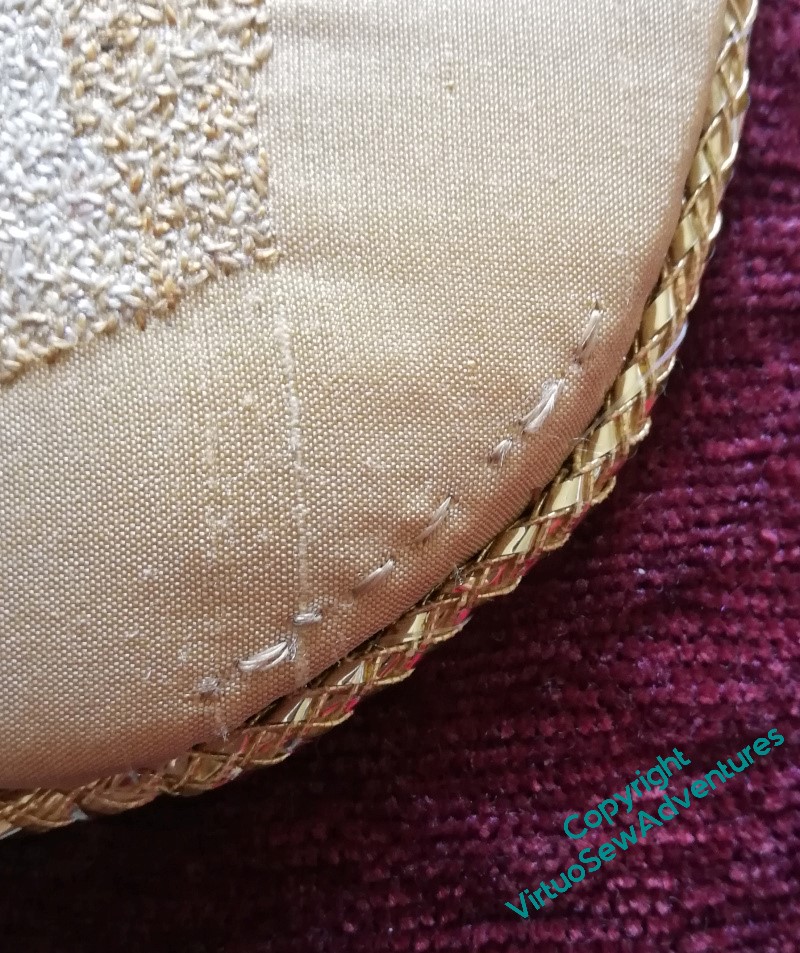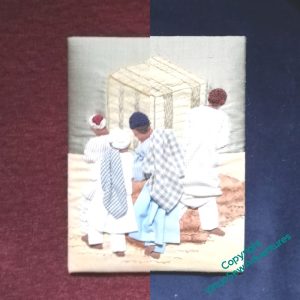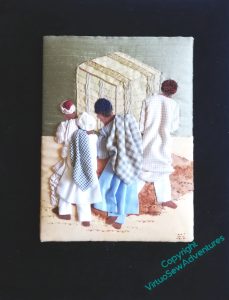Tag: Head of Ankhsenpaaten
Mounting Choices Again
There were some quandaries about mounting “Loading The Felucca”. Burgundy? Navy? Copper? Brown? I posted these pictures on various social media sites – each of which picked a different preference, which wasn’t helpful at all, but at least left me free to apply my own judgement.
So I chose the same navy blue velvet I used for the Amarna Royal Family. All the other fabrics had something going for them, but the navy blue brought out the colours and shapes more emphatically and truly – although I fear you will have to take my word for it, as my photograph doesn’t really bring out the blueness of the velvet!
However, in the course of the final mounting process, I discovered that the embroidery was no longer visibly signed. Curses!
Then I checked, and neither was Ankhsenspaaten. Curses again!


They are now…
Mounting Ankhsenspaaten
After some thought, I decided to take the inspiration of mounting for the Head of Ankhsenspaaten from Victorian mounts for minaiture portraits, so I went to my local framer, who goes by the not-at-all-exaggerated business name of “Framing Genius” (seriously, quite apart from any headaches I may give her, I’ve seen some of the other things she’s been asked to do!), and we worked out what size of oval would work for this idea. Then her clever computer controlled cutter cut out an oval that was exactly the size and proportions I wanted.
Further thought, and some playing with cards and fabrics, helped me to decide to use for her background the same burgundy chenille upholstery fabric that I eventually used to mount the Colossus of Akhenaten. None of the Amarna pieces are going behind glass – if eventual owners wish to do so, that’s their prerogative, but I like the immediacy of feeling you get, looking at a fabric or thread without any glass in the way – so the next job was to stretch the burgundy over a wooden frame and use that wretched curved needle to ladder stitch the two together.
I may be being unfair. I still don’t find a curved needle at all natural to use, but I am at least beginning not to whimper every time I look at it. It’s very useful for the purpose I’m using it for!
Once I had her neatly mounted, I sat back for some of my usual Thoughtful Staring.
The original inspiration sometimes had a cord or ribbon trim around the oval of the miniature – maybe as it stands the transition is a little abrupt?
I’ve a small collection of odd metallic cords bought at an Embroiderer’s Guild Sale, so I rummaged in that, and found something that might work.
Then I looked a little harder and realised that the thread I had used to attach the oval to the velvet would show. For the first time, I found a use for the Peri-Lusta Invisible Thread I found in my Grandmama’s workbox!
I’ve not got the gold thread quite correctly placed yet (I ran out of patience with myself at this point), so I need to spend a bit of time tweaking that, but I think where it is in the right place it is definitely improving the look.
Now, where had I got to…?
What with one thing and another, it is quite some time since you last saw Ankhsenpaaten. I had got quite a long way, and was pleased with progress, but still not entirely sure about her.
Then, of course, we had the Christmas period, and I don’t even attempt to stitch anything that requires serious concentration during that time. There are simply too many other things competing for my attention.
And besides, my favourite place in which to stitch is occupied by the tree….
So when I came back to her, I was full of trepidation. This seems like such a simple way to create an image, but in order for the “Stare Hard and Then Stitch” approach to be really successful, I need to have some sense of the whole thing in my head, so that the stitch sizes and threads all fall naturally to hand as each element is worked and reworked. The long break, and a variety of other things happening in the background, mean that my mental “map” of this piece had fallen out of my head, and needed to be painfully clawed back in again.
And “painful” was indeed the word. I’ve not regained the sense of surety I was beginning to feel at the point when I stopped working on it.
However, I continued to juggle with lights and darks, adding some of the details in the extension of the head and neck at the back which supports the stone in an upright position, staring and then stitching, and stitching and then staring.
I’ve brought the strong darks around the ears a little more to the fore, emphasized the light area down the side of the face, and brought a little more detail around the mouth and the line of the jaw.
There are elements of this I’m still not entirely confident about, but I am also becoming afraid of going too far, and ruining it by doing too much.
Time to stop, turn my back, and come back when my anxieties have stepped into the background and I can judge more truly. I’m declaring her “provisionally finished”.
Head of Ankhsenpaaten – more progress
Once I had a single layer of stitches I removed the running stitch outline. Not as easy as you might hope, because my “real” stitching had caught some of them, but doesn’t it look better without!
The angle of the photo shows but doesn’t over-emphasize the slightly elongated skull the family had, and you can almost see this little girl as a daughter of Nefertiti – the same fine-drawn features, softened by youth and lack of care.
The next thing to do was to add in some of the mid tone darks. The photograph I’m working from does have some quite strong shading, and I felt that in spite of my early Dark darks, there wasn’t quite enough form.
However, this point I had a bit of a wobble, because I was wondering whether I’d done too much dark. Looking at the photo, I now think not, but I do need a mid-mid-tone to blend in the curves of the face a little bit more.
However, I put in more lights to help myself back on track.
You can see, if you click to enlarge the photo, very light cream stitches around the highlight on the temple, on the eyelid and around the curve of the nostril and the light areas around the lips.
I need to extend some of these, and add those pesky mid-mid-tones. But I do think it’s going to work.
And I’m completely astonished at myself. I’ve approached this almost as I approach a watercolour, and you wouldn’t have thought embroidery – certainly not my embroidery – would be amenable to such treatment.
Gosh.
Head of Ankhsenpaaten – progress
There is relatively little to say about Ankhsenpaaten, because the form will be created with loads of seed stitches in slightly different shades of silk thread, so there will simply be more of the same.
However, you may find it interesting to watch it come into focus, so I will post a series of pictures, along with what comments I feel I can make.
Do click on the pictures for a closer view, and a better sense of what is happening.
You can see from the earlier post that I only transferred the most basic of outlines, so I am using the photograph as my reference and working the various shades over one another to develop the layers of colour and shade.
I have started by trying to understand the most basic planes of the face and the shades needed to bring them alive.
I tend to find it much easier to get my bearings if I can get some of the darker areas in, because that gives me the beginnings of a sense of depth and form. It is, however, a slightly terrifying approach, because there’s something so very definite about a truly Dark dark!
One of the shades of silk is very close to the fabric, but there is just enough difference that the light bouncing off it creates a sense of difference between inside the lines and outside the lines.
Head of a Princess
One of the crowning finds of the season was a small carved stone head, interpreted as depicting one of Akhenaten and Nefertiti’s daughters, Ankhsenpaaten. I know the princesses (two of them!) have already appeared, but that is a separate piece, whereas this version may be able to form part of the main panels.
I gathered several source photographs and some fabric, and Thought Hard.
And decided to challenge myself. Whenever will I learn?
So I’ve stretched a piece of calico over some small stretchers, and attached a rather nice piece of silk over the top.
Then I’ve traced the main elements of the head onto tissue, and transferred it using running stitch. I’m going to need to be careful, because I want to be able to remove these running stitches when I’ve finished, but there is a lot of stitching to do yet.
I just hope I’ve transferred enough to give me the right level of guidelines!
I’m going to use seed stitches in several different shades of spun silk, hoping to end up with something of the granular effect that some stone has. I’m starting with one layer of seeding, staring hard at the source photo and stitching clouds of seed stitches to give the first level of dimensionality. It is going to take quite a while to do this, especially when you consider that it is a very simple technique.
Simple in principle, that is. In execution, not so much!



















